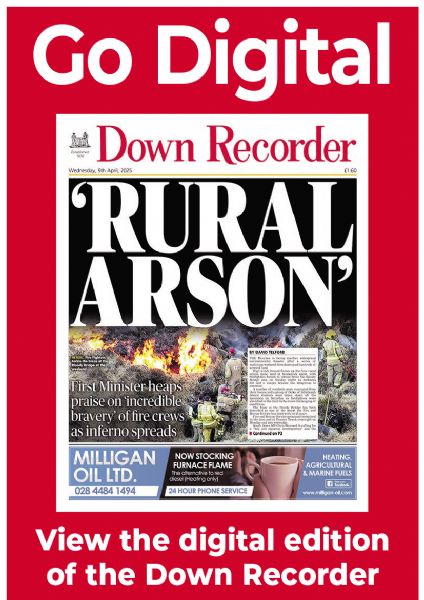Film reels off vivid memories of wartime in Killyleagh
Film reels off vivid memories of wartime in Killyleagh
9 December 2020
WORK has been completed on a unique film which recalls life through the Second World War in Killyleagh and Shrigley.
Production on the documentary got underway at the beginning of the year to mark the 75th anniversary of the end of the Second World War and VE Day.
But rules around social distancing, brought on by the Covid pandemic, have delayed filming and its completion, while the current circuit breaker put paid to plans to screen the film in Killyleagh on Remembrance Weekend last month.
Filmed and produced by documentary maker Doug Beattie, from Ballygowan, it uses the voices of Killyleagh residents to tell the stories of 1939 to 1945, when Killyleagh and Shrigley were home to American GIs and Welsh, Scottish and English soldiers preparing to go to war.
Narrated by TV presenter Paul Clark, it has been supported by the Heritage Lottery Fund.
The documentary features the town’s last surviving war veteran, 99 year-old Martin ‘Tina’ Charters, filmed before the new social distancing rules came into place.
Mr Charters left Shrigley at the age of 20 and joined the RAF. His first job was as a mechanic looking after a fleet of Spitfires in South Wales.
He talks about his lucky escapes while serving as a rear gunner with Bomber Command in more than 40 missions over Germany.
“It was heartbreaking at times. I remember men crying before we set off because they were terrified to go on the mission,’’ recalled Mr Charters.
Among those Mr Charters recalls is Albert Jess, from Killyleagh, who served with RAF 102 squadron. A sergeant, he was a wireless operator/air gunner when his plane was shot down over Hamburg in Germany in March 1941. He was aged just 19.
The stories include the background to a wedding photo of a member of the 59th Staffordshire Regiment who married a Killyleagh woman and put roots down locally; Zena McAllister, the child evacuee who returned to her Killyleagh home during the Belfast Blitz of 1941; and the lost life of Charles Kelly, from Irish Street in Killyleagh, who made the ultimate sacrifice when his ship, HMS Matabele, was sunk by a German U boat. Out of 242 sailors on board, only two survived.
A spokesman for the Killyleagh Remembers the War group explained: “So many of the stories are heartbreaking.
“The documentary was to be part of an overall programme of events which have now been delayed due to the coronvairus lockdown. We hope to run many of these in 2021 but sadly we will not be able to have a street party.
“The Killyleagh of today is the richer for the influx of the war time visitors — the child evacuees from the Belfast Blitz; the Jews who set up leather tanning in Shrigley while fleeing Hitler’s purge; and the American, Scottish, Welsh and English soldiers who at different times made Killyleagh and Shrigley their home.
“It is these stories we are seeking to preserve for the future in this superb short film from Mr Beattie, as well as paying tribute to the 21 men from the Killyleagh district who paid the ultimate price by laying down their lives between 1939 and 1945.’’
The documentary also features photos of the Killyleagh Home Guard, set up in 1940, and recalls one of the earliest impacts of the war on the area was the arrival of a prison ship, the Al Rawdah, which was moored just off Killyleagh. It was used to house republican prisoners and internees.
There is a musical contribution from local song writer Ian Singleton whose father served in the war.
Paul Clark narrates that in May 1942 the Down Recorder newspaper reported that when a second wave of American soldiers arrived in Northern Ireland, the secrecy surrounding troop movements and censorship rules meant the newspaper could not identify who the GI’s were, or where they were based.
They were, in fact, soldiers of the 1st Armoured Division, from Kentucky, who had set up base in a number of towns within a 15 mile radius of Downpatrick, including Castlewellan, Newcastle, Ballykinlar, Crossgar and Killyleagh.
While locals in Killyleagh struggled to get used to the new arrivals, their presence was kept a secret to the world outside. In fact it is almost three months later before the first Killyleagh reference is made in the Recorder to American soldiers providing “valuable assistance’’ at a garden party at the Gocean.
Many of those GI’s were to die within nine months of that photo being taken, They were to become part of the first American armoured division to see combat with the German forces in World War 2, firstly as part of Operation Torch in North Africa (Tunisia) and then in Italy.
Three long, hard years later VE Day in May 1945 was marked by celebrations in Killyleagh, with music and dancing in the Castle Square, culminating in the lighting of a bonfire featuring an effigy of Hitler.
For many, though, it was not a day of joy. Their thoughts were with the 21 men who had been killed.
In a town steeped in history, their names are now etched in stone on the town’s War Memorial.
Free copies of the film are to be made available from the middle of this month to all those who took part in filming and who have supported the war project over the past six years. It is also hoped to have the film premiered online.
“We hope to make available, before Christmas, any surplus copies with a suggestion that a token donation is made to the Royal British Legion’s Poppy appeal,’’ the spokesman added.


